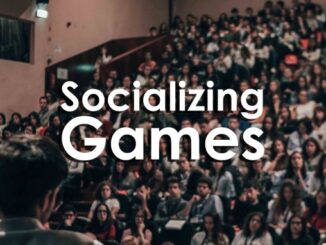
“The voluntary attempt to overcome unnecessary obstacles”
This is how Bernard Suits defines games, in his book ‘The Grasshopper’, first published in 1978. When a player agrees to enter into the world of the game, she does so by adopting something that Suits referred to as the Lusory Attitude.
The rules of a game are arbitrary and the Lusory Attitude involves acceptance of these rules. These rules constitute, in part, the ‘obstacles’ that the player will encounter. And it is in overcoming these obstacles that the ‘fun’ of playing is to be had – the pleasure derived from overcoming and prevailing.
The Grasshopper is available on Amazon
Without these obstacles a game is trivial and is therefore less compelling to the player.
So, is there more fun to be had if there are more obstacles, or if the obstacles are more challenging? Behaviour of some players might suggest that this is the case.
House Rules
Anybody who plays games socially has probably come across the idea of ‘House Rules’ – unofficial modifications to the rules of a game that are played by specific groups of people. These might be played in a family to even the playing field between adults and children. They can completely change the experience of a game and many groups will adopt house rules to increase replayability.

Many people will adopt house rules, either in groups, or individually, to increase the challenge of what they are facing. The kind of ‘house rule’ which makes the challenge harder for the player are the ones I am specifically interested in here. I know, for example, someone who has adopted his own ‘hard mode’ when playing Wordle. Once a letter has been confirmed as being in the word, it must be used in every subsequent guess, and if it has been confirmed as being in its correct position, it must be used in that position. (ed’s note – I have subsequently discovered that ‘hard mode’ is a Wordle setting, built into the game and not a ‘house rule’. As someone who plays wordle every day, I am both confused and embarassed that I did not know this)
As you can imagine this reduces massively the possibilities for introducing (and potentially ruling in or out) new letters, and makes Wordle a much harder challenge. Having tried this myself, I can confirm that it does also increase the feeling of achievement on success, partially because failure is so much more likely.
House rules in board games vs video games
It would seem on the face of it, much easier to adopt house rules in board games, than in video games where one’s interaction is prescriptive, at least in terms of the interface. But many house rules go on in the player’s head, and are to do with the player’s choices in play, rather than ‘bending’ any of the mechanisms. The Wordle example above illustrates this.
In more complex games, say MMORPGs, players can add challenge by deliberately choosing to approach challenges while underpowered or underequipped, or by taking a more challenging route to their end goal.
In RPGs generally, including the tabletop kind, the adoption of house rules is sometimes known as ‘Rule 0’, an acknowledgment that ‘playing as you want to’ is literally the most important ‘rule’ of the activity. In keeping with the current theme of Ludogogy, these ‘make it harder’ house rules are really personal quests, over and above those offered by the game if it is played as designed.
Self-gamification and Hypermiling

Changing the ‘rules’ to increase challenge can also happen outside of things that are recognised as games. And this is, of course, one of the fundamental aspects of gamification. Where this happens as ‘house rules’ rather than being part of some gamified application, it has a lot in common with Self-Gamification (a topic which is explored in detail in many Ludogogy articles by Victoria Ichizli-Bartels). While there is often a focus on reward, when thinking about gamification, it is the addition of ‘unnecessary obstacles’ which actually makes this gameful.
Let’s say you want to create a regular practice of writing, and you set up a system to record the number of words you write and reward you for carrying out your practice. You do not NEED to write 500 words a day; it is the unnecessary obstacle you have elected to overcome. Although you have specified a reward, that is really just a recognition that you repeatedly overcome your obstacle.
It is the limit (of 500 words) which makes this an unnecessary obstacle, rather than simply a task you want to perform, because that measure gives you a finite point at which you have achieved. In short, an obstacle is not an obstacle unless you can achieve by overcoming it. ‘Writing’ is not an obstacle – 500 words is.
Another gamified activity which many have chosen to participate in recently (at least according to the Guardian) is Hypermiling.
This is the practice of optimising driving to get the maximum distance from your fuel. The unnecessary obstacle you are constantly seeking to overcome is your current MPG (or KPG, KPL, whatever). While saving fuel is already desirable (especially given current prices), stating an obstacle, not only makes your success measurable but makes the practice ‘fun’ – and perhaps those two are one and the same thing.
House Rules in a Learning Setting
In learning settings the use of ‘house rules’, might provide us with several interesting possibilities. In this article we are only looking at ‘challenge’, but obviously there are other kinds of house rules which could alter the experience in other ways.
- If a player can adjust the level of difficulty of the challenges they face in the game, they are more likely to be engaged, being in a state of flow.
- In workplace learning it is not unusual for employees of different grades / job roles / experience to need to approach the ‘same’ learning at differing levels of challenge, so the ‘house rules’ flexibility allows for increased relevance to individual learners.
- If the players themselves are the ones who create the new rules, this is, in itself, a creativity practice which facilitates valuable ‘incidental’ learning, whatever the topic of the learning experience.
- If ‘house rules’ are recorded, they can provide a valuable resource for use with future cohorts or in future learning game designs to implement situations where challenge is required.
We could do this by ‘designing in’ several different rule options in different situations, but this carries a considerable design overhead, and it is also impossible to design a sufficiently diverse rule set to fully realise the advantages above with all cohorts of learners.
A far more sustainable option, which also optimises differentiation, would be to implement a learning /playing environment which encourages the creation and use of ‘house rules’ by players. In fact, the idea of ‘house rules’ requires that players are the ones which devise them, so if they were ‘designed in’ before they wouldn’t be ‘house rules’ at all, just alternative rule sets.

Examples of the kinds of rules (or quests) that players might devise might be:
- Acting with fewer resources (than usual) within the game
- Acting / decision-making with less information than is usual
- Beating a previous outcome in the game
- Setting constraints within which to play (‘Do x within 4 turns’, Do y without the support of my team’ etc.
How to design for or encourage house rules
Many people like to ‘follow the rules’ and will find the idea of a game where you can ‘bend the rules’ a little intimidating, especially if they are not used to being asked to exercise their creativity in coming up with new ways to do things.
It is easier therefore not to design rigid rules which then have to be ‘broken’ but to design a more open playing / learning environment in the first place, upon which players can then apply their own constraints. Get players to think about the constraints they already act under in the situation which the learning relates to. Typically, constraints relate to:
- Time
- Information
- Money
- Other resources
- People (as in headcount)
- Capacity and capability
‘Do-overs’ are a useful structure to implement, because they allow players to try different constraints on different instances of play.
If play starts with players/teams well-resourced, with all the information they need to achieve easily, learning can gradually be ramped up by removing resources, or increasing constraints with each iteration.
Providing a challenge, with a stated outcome, but not specifying how the outcome will be achieved, gives players considerable latitude to design their own route to achievement. Asking ‘What would you need to make that easier to do?’ provides clues also as to what would make it more difficult, and players can try to achieve both with and without their ‘aid’.
Set up a ‘bidding war’ where teams / players compete to identify the ‘most difficult’ route to achieving the outcome. As an example of this (not probably one you would use in workplace learning setting), think of the ‘Name that Tune’ challenge, where players compete to name the tune in the fewest number of notes. This has recently been implemented in Wordle style as Heardle.
Make sure you record any ideas that either you or players create as you go. These will prove valuable later on to inform further design of challenge-based learning.
- James Bore – The Ransomeware Game - 13th February 2024
- Ipsodeckso – Risky Business - 23rd January 2024
- Review – Luma World Games - 15th December 2023





Be the first to comment